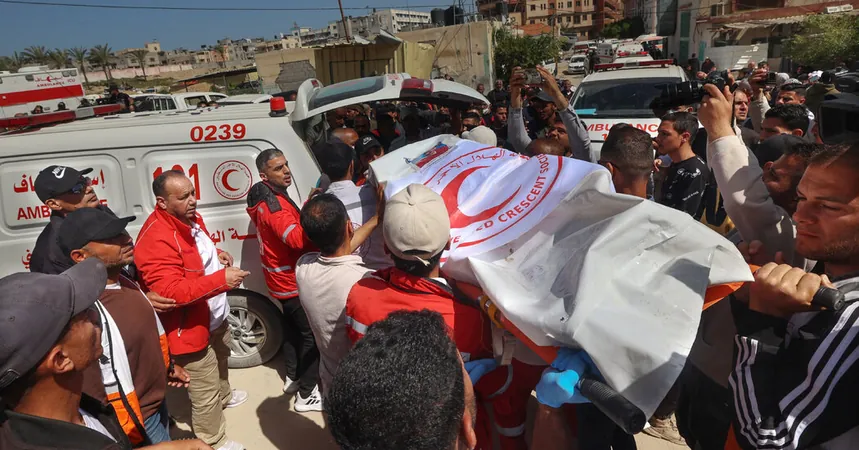
Uncovering the Tragic Deaths of Gaza Aid Workers: What Really Happened?
2025-04-06
Author: Jessica Wong
The situation surrounding the tragic deaths of 15 paramedics and rescue workers in southern Gaza last month has taken a dramatic turn as the Israeli military admits to inconsistencies in its earlier accounts. This acknowledgment comes after a revealing video obtained by The New York Times contradicted the military's claims, igniting international outrage and calls for transparency.
Initially, the Israeli military maintained that its troops opened fire on a convoy approaching them "suspiciously" in the dark. They claimed that the vehicles lacked headlights and emergency signals. However, the video clearly showed that the vehicles were marked ambulances and a fire truck, raising serious questions about the military's narrative.
As global scrutiny increased, the military’s response has been unusually swift, contrasting with the typically prolonged investigations into fatal incidents. Here’s what we know so far:
Conflicting Accounts from the Israeli Military
Upon discovering the bodies, the Israeli military insisted that the attackers were responding to a convoy that had approached their position. They previously alleged that nine of the deceased were affiliated with Hamas or Islamic Jihad, but failed to provide evidence for these claims. A military official recently disclosed that at least six of the 15 victims were purported Hamas operatives, still without offering concrete proof.
The account from the military now includes a sequence of events where, prior to the arrival of the emergency vehicles, reserve forces from an infantry brigade had been lying in ambush. Before the dawn hours of March 23, they allegedly engaged and killed two Hamas security personnel.
As dawn broke, the emergency convoy reportedly approached the area. When responders began to exit their vehicles, the Israeli forces misinterpreted the actions, assuming they were Hamas militants, and opened fire from a distance.
Military analyst Amos Harel noted that while the soldiers had reasons to feel anxious, it is crucial not to jump to conclusions of "murder in cold blood." His observations stress the complexity of the situation, highlighting the misuse of civilian infrastructure by militant groups such as Hamas.
Despite military denials regarding the state of the bodies—reports suggested some were found bound and executed—the official stated that the troops had buried the bodies to protect them from wild animals and used heavy machinery on the disabled vehicles, which were substantially damaged.
Aid Groups' Perspective
The Palestine Red Crescent Society has fervently disputed the military's claims, asserting that their ambulances were dispatched around 3:30 a.m. to aid civilians injured by Israeli shelling. They confirmed that their ambulance and crew were directly hit by gunfire, prompting additional rescue units, including another ambulance, a fire truck, and a U.N. vehicle to respond.
In total, 17 individuals were sent out, comprising 10 Red Crescent workers, six civil defense emergency responders, and one United Nations worker. Their mission was critical—providing life-saving assistance during a chaotic and violent early morning.
This horrifying incident underscores the increasing dangers faced by humanitarian workers in conflict zones, where the line between combatants and civilians continues to blur. As the inquiry unfolds, the world watches closely, hoping for accountability and justice for the brave souls who risk their lives to aid others amid crisis.


 Brasil (PT)
Brasil (PT)
 Canada (EN)
Canada (EN)
 Chile (ES)
Chile (ES)
 Česko (CS)
Česko (CS)
 대한민국 (KO)
대한민국 (KO)
 España (ES)
España (ES)
 France (FR)
France (FR)
 Hong Kong (EN)
Hong Kong (EN)
 Italia (IT)
Italia (IT)
 日本 (JA)
日本 (JA)
 Magyarország (HU)
Magyarország (HU)
 Norge (NO)
Norge (NO)
 Polska (PL)
Polska (PL)
 Schweiz (DE)
Schweiz (DE)
 Singapore (EN)
Singapore (EN)
 Sverige (SV)
Sverige (SV)
 Suomi (FI)
Suomi (FI)
 Türkiye (TR)
Türkiye (TR)
 الإمارات العربية المتحدة (AR)
الإمارات العربية المتحدة (AR)